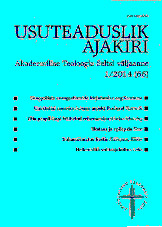Inimese varjatud mina: unustatud seesmise inimese aspekt Paulusel
The hidden I of a Human Being: the Forgotten Aspect of Paul’s View of the Inner Man
Author(s): Randar TasmuthSubject(s): Christian Theology and Religion
Published by: Akadeemiline Teoloogia Selts
Keywords: New Testament; Pauline studies
Summary/Abstract: Rudolf Bultmann sought to shape the big picture of Paul’s understanding of the human being, and thereby made an anthropological generalization by stating that Paul saw the body, sōma, for the whole person. Paul ascribed to the inward man a significant aspect of human beings, since the inner man is connected intimately with the mind, the process of moral decision making, and also represents a rational aspect of the human I, which is in harmony with the law of God. This reasonable human I has much in common with the heart which denotes the believing I (Rom 10:9) and the motivating I (2Cor 3:3, 15). Even if Plato’s expression may have been in the background, however, Paul’s view of the inner man is not so optimistic and does not give the man within us dominion over the entire man and make him take charge of all activities of the I. Philo’s belief that God established the real man in us – m the mind (nous) –, and that this true man is the mind endowed with reason, was probably known to some extent in Hellenistic-Jewish circles. According to Paul, however, the mind does not dwell in the soul of each of us, but is an aspect of the human I. Paul understood the inner man as a “metaphoric” area where contact between man and Christ can take place (2Cor 13:5). In 2 Corinthians Paul created an antithesis the outer man to the phrase the inner man, the former designating human body in synonymous way. These ideas have influenced the presentation of early Christian anthropology for decades.
Journal: Usuteaduslik Ajakiri
- Issue Year: 2014
- Issue No: 1 (66)
- Page Range: 25-44
- Page Count: 20
- Language: Estonian

